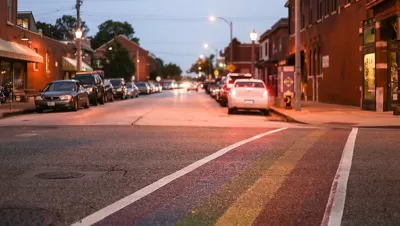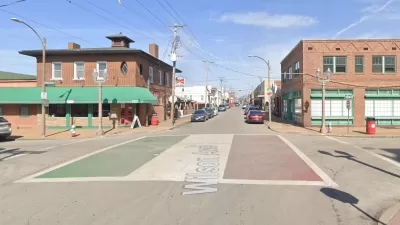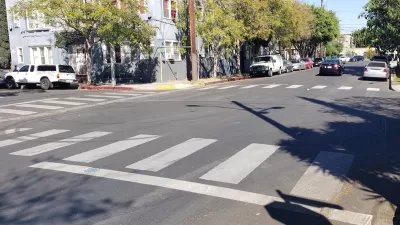St. Louis will end a program that allows groups to decorate crosswalks for the purposes of beautifying and branding neighborhoods. Currently decorated crosswalks can stay, for now.

"Say goodbye to the decorated fleur-de-lis and rainbow crosswalks that grace some intersections in St. Louis," reports Kristen Taketa. "The city now prohibits such crosswalk art projects, and the ones that exist will be left to fade away."
The sudden resistance to the city's painted crosswalks is credited to a 2011 Federal Highway Administration (FHWA) policy that says colorful crosswalks pose a danger. Taketa quotes directly from the policy, which says "crosswalk art is actually contrary to the goal of increased safety and most likely could be a contributing factor to a false sense of security for both motorists and pedestrians." According to the FHWA, problems could arise from misidentifying the borders of a crosswalk or from pedestrians who pause to gaze at the crosswalk.
Jamie Wilson, St. Louis bike/pedestrian coordinator, is also quoted in the article, assuring that none of the city's existing painted crosswalks will be removed "unless he learns they are actually causing problems." Wilson in quoted directly explaining the city's decision: "I don’t honestly believe someone’s going to trip over a fleur-de-lis crosswalk, but at the same time we want to be consistent with the memo the feds put out….It’s probably an ultra-conservative approach when it comes to safety, which is fine."
The reaction of the neighborhood groups that have already painted their crosswalks was disappointment—one in particular notes the unprecedented popularity of the crosswalks when compared to other forms of public art. According to Taketa, "Some groups, such as Tower Grove, still plan to put in more crosswalk art projects that fit within federal guidelines. That means using patterns with more 'natural' ground colors that distract less from the traditional white crosswalk lines."
FULL STORY: St. Louis will let crosswalk art that violates federal rules fade away

Study: Maui’s Plan to Convert Vacation Rentals to Long-Term Housing Could Cause Nearly $1 Billion Economic Loss
The plan would reduce visitor accommodation by 25,% resulting in 1,900 jobs lost.

North Texas Transit Leaders Tout Benefits of TOD for Growing Region
At a summit focused on transit-oriented development, policymakers discussed how North Texas’ expanded light rail system can serve as a tool for economic growth.

Why Should We Subsidize Public Transportation?
Many public transit agencies face financial stress due to rising costs, declining fare revenue, and declining subsidies. Transit advocates must provide a strong business case for increasing public transit funding.

How to Make US Trains Faster
Changes to boarding platforms and a switch to electric trains could improve U.S. passenger rail service without the added cost of high-speed rail.

Columbia’s Revitalized ‘Loop’ Is a Hub for Local Entrepreneurs
A focus on small businesses is helping a commercial corridor in Columbia, Missouri thrive.

Invasive Insect Threatens Minnesota’s Ash Forests
The Emerald Ash Borer is a rapidly spreading invasive pest threatening Minnesota’s ash trees, and homeowners are encouraged to plant diverse replacement species, avoid moving ash firewood, and monitor for signs of infestation.
Urban Design for Planners 1: Software Tools
This six-course series explores essential urban design concepts using open source software and equips planners with the tools they need to participate fully in the urban design process.
Planning for Universal Design
Learn the tools for implementing Universal Design in planning regulations.
City of Santa Clarita
Ascent Environmental
Institute for Housing and Urban Development Studies (IHS)
City of Grandview
Harvard GSD Executive Education
Toledo-Lucas County Plan Commissions
Salt Lake City
NYU Wagner Graduate School of Public Service





























